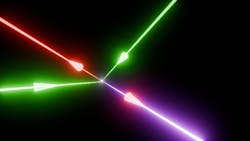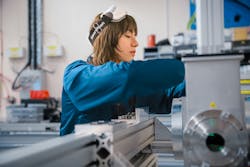Physicists simulate way light interacts with empty space
A group of physicists from the University of Oxford in the U.K. and Instituto Superior Técnico at the University of Lisbon in Portugal recently created real-time three-dimensional (3D) simulations of the way intense laser beams alter the quantum vacuum—a state quantum physics predicts is full of virtual electron-positron pairs—and recreated vacuum four-wave mixing (see video).
What is vacuum four-wave mixing? A theoretical quantum effect in which the combined electromagnetic field of three focused laser pulses can polarize the virtual electron-positron pairs of a vacuum and make photons bounce off each other like balls on a pool table to generate a fourth laser beam during a “light from darkness” process.
This work is a step closer to “experimental confirmation of quantum effects that until now were mostly theoretical,” says Peter Norreys, a physics professor at the University of Oxford.
“The quantum vacuum is one of the most fascinating predictions of quantum electrodynamics (QED),” says Zixin “Lily” Zhang, a Ph.D. student working with Norreys, who is a Clarendon scholar and whom Norreys notes has an extraordinary talent for physics. “It challenges the classical perspective of a vacuum as an empty space, and instead pictures it as a sea of virtual particles—like electrons and positrons—that pop in and out of existence. Despite QED being one of the most well-tested physics theories, there have been no successful direct tests on the nature of the quantum vacuum. But the global emergence of multi-petawatt lasers sparked our interest in testing the vacuum using just light.”
Simulations/solver
To run their simulations, the group used an advanced version of OSIRIS, which is a simulation software package that models interactions between laser beams and matter of plasma. It essentially provides a time-resolved 3D look into quantum vacuum interactions not previously possible.
The group’s solver is based on the Heisenberg-Euler Lagrangian effective theory, which describes how the vacuum responds to the electromagnetic fields when they’re strong but still below the Schwinger limit (above it, an electromagnetic field is expected to become nonlinear).
“This approach allows us to shift from a fully quantum picture, where light is treated as photons, to a semiclassical one that treats light as electromagnetic waves,” explains Zhang. “Within this framework, the vacuum behaves like a nonlinear optical medium and manifests effects like birefringence similar to those seen within nonlinear crystals.”
It’s based on nonlinear Maxwell’s equations and implemented via a numerical technique—a.k.a. the “Yee method”—widely used for plasma simulations.
“The key challenge is the nonlinear terms, which depend on the electromagnetic fields,” says Zhang. “To address it, we combined the Yee method with an iterative loop to update the nonlinear response at each time step until the solution converges. And we integrated our solver into OSIRIS, a state-of-the-art massively parallel particle-in-cell code, which allows us to take advantage of built-in tools like laser pulse initialization and even particle generation.”
When the physicists put their method to the test with a three-beam scattering experiment and captured the full range of quantum signatures, they came away with detailed insights into the interaction region and its key time scales. After benchmarking it, they now hope to focus on more complex scenarios like exotic laser beam structures and flying focus pulses.
“We’ve validated the solver in two dimensions (2D) and 3D against analytical predictions for vacuum birefringence, and extended it to simulate more complex effects like four-wave mixing—with results that match the literature well,” says Zhang.
What does this mean for the quantum realm? “Previous numerical tools were limited in scope and often constrained to simplify laser setups or 2D models,” says Zhang. “Our solver can simulate realistic real-time and full-scale 3D laser interactions with the quantum vacuum, which provides researchers with a much richer dataset and more accurate estimates for near-future experiments.”
Most thrilling aspects of this work? “It was to see the solver running and deliver the expected results,” Zhang says. “There certainly was a lot of debugging throughout the process, but watching the simulations behave exactly as predicted was truly satisfying and validating.”
High-energy laser experiments to probe quantum phenomena on horizon
As the world’s newest generation of ultrapowerful lasers start to come online, such as the U.K.’s Vulcan 20-20, the European Extreme Light Infrastructure (ELI) project, and China’s Station for Extreme Light (SEL) and SHINE facilities, they’re poised to deliver high enough power levels to potentially confirm photon-photon scattering within the lab—which would be a first. The U.S. National Science Foundation’s OPAL dual-beam 25-petawatt laser facility at the University of Rochester, for example, is pursuing photon-photon scattering as one of its flagship experiments.
This is where the group’s tool comes in: Its models provide details that experimentalists require to design precise real-world tests such as realistic laser shapes and pulse timings. The simulations also reveal how these types of interactions evolve in real time and how subtle asymmetries in beam geometry can shift outcomes.
Experiments planned at these advanced laser facilities will be able to take advantage of the group’s solver. “The combination of ultra-intense lasers, state-of-the-art detection, and cutting-edge analytical and numerical modeling are the foundations for a new era in laser-matter interactions, which will open up new horizons for fundamental physics,” says Luis Silva, a physics professor at the Instituto Superior Técnico, University of Lisbon and visiting professor in physics at the University of Oxford.
3D real-time simulations “have always been computationally costly,” points out Zhang. “Our solver uses a matrix-free numerical method that makes the computation process more efficient and allows us to run fully 3D simulations for a three-beam setup, which to our knowledge hasn’t previously been achieved. There’s still work to be done to improve the speed and scalability to make these simulations more accessible to running on just a few central processing units (CPUs).”
The group’s solver is ready to use now and available upon request. It can model a range of quantum vacuum effects in arbitrary laser configurations, such as birefringence and four-wave mixing. And the physicists are looking forward to other researchers applying it to their own experimental designs or theoretical studies.
“We’re currently exploring new physics using the simulation results from the solver—including novel beam profiles,” says Zhang. “The algorithm of the solver also makes it straightforward to implement other nonlinear theories beyond QED, such as Born-Infeld electrodynamics and Axion fields. Our goal is to build toward a comprehensive simulation toolkit for the quantum vacuum.”
FURTHER READING
Z. Zhang et al., Commun. Phys., 8, 224 (2025); https://doi.org/10.1038/s42005-025-02128-8.
About the Author
Sally Cole Johnson
Editor in Chief
Sally Cole Johnson, Laser Focus World’s editor in chief, is a science and technology journalist who specializes in physics and semiconductors.


